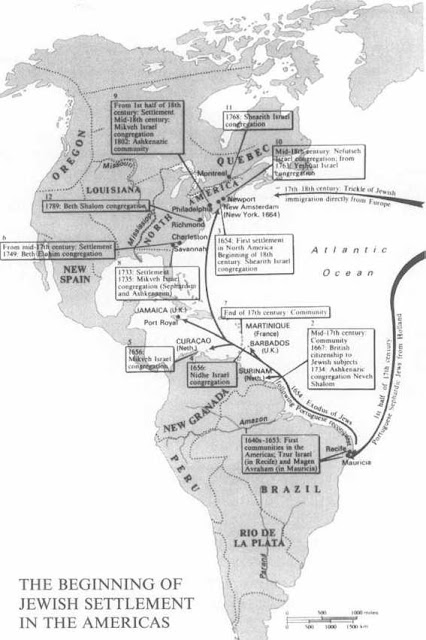 |
| A Dutch view of New Amsterdam nine years after it was conquored by the English and renamed New York> note the militia drilling. |
On August 22, 1654 Jacob
Barsimson became the first known Jew
to take up residence in what is now the United States. Barsimson disembarked a ship from The
Netherlands that day in Nieuw-Amsterdam (New Amsterdam), the capital
of the colony of New Netherlands. The
city was still a raw frontier trading post huddled next to the protective
parapets of a fort for protection from both the local natives and
the voracious English.
Barsimson,
an Ashkenazi, was sent as an emissary by
wealthy Dutch Jews to check out the suitability of the North American
colony for settlement by Jews being persecuted in earlier attempts
to establish New World footholds in Brazil and the West
Indies.
 |
| A map shows early Jewish migration routes and settlements in the New World including Sephardi Portuguese Jews from The Netherlands at Recife, Brazil and Dutch Caribbean Islands like Curauo. |
The Dutch
Republic had become a place of refuge for all sorts of religious
dissenters and outcasts once it had finally thrown out the Hapsburgs
and with them the Inquisition.
During the same years the Netherlands was harboring Unitarian refugees
from Poland and other persecuted minorities. Of course, no one in Europe was more
persecuted than the Jews.
A sizable
community, mostly from Portugal where the Inquisition was still going
strong, had established itself in Amsterdam and was prospering. But Jews had prospered here and there in
Europe before and had the tides of prejudice rose against them time and
time again. The merchants of
Amsterdam were looking for escape routes for themselves, as much as for
their cousins in Brazil.
Despite
being less than welcomed by Governor Peter Stuyvesant, Barsimson saw promise in the new city. On October 22 he was on hand to welcome the
first group of 23 settlers from Recife,
Brazil. Together they started the first Jewish community in North America, four years before the
founding of another enclave at Newport,
Rhode Island.
Others
joined them along with some from the Dutch sugar islands in the
Caribbean. Stuyvesant became
increasingly alarmed by the influx and imposed harsh restrictions
on their occupations and trade opportunities.
 |
| Barsimson frequently got the best of his nemesis Governor Peter Stuyvesant by going over his head to the Governors of the Dutch West India Company. |
Barsimson,
the acknowledged leader of the community, found himself in an ongoing game with
the governor to secure rights and privileges for his people. Jews were barred from most trades,
shop keeping, public office, conducting religious services,
and participation in the militia.
When Stuyvesant turned down a simple request to allow
Jewish burials on the grounds that it was “premature”—no Jews had yet
died—Barsimson appealed over his head to the directors of the West
India Company which controlled New Amsterdam and in which several wealthy
Jews were large investors. The
company ordered their governor to reverse his decision.
It was a
pattern Barsimson would repeat. He
shrewdly observed that among the many restrictions placed on Jews was service
in the militia and taking their turns at arms guarding the walls for the
fort. He understood that the rights
of citizenship were tied to the responsibility to defend
the colony. Despite the continued threat
of Indian attack and the growing menace from the English and from a new Swedish
colony established in what is now Delaware by former New Amsterdam
governor Peter Minuet, Stuyvesant refused the appeal for Barsimson and
another Jew, Asser Levy for the right to take their turn at guard
duty. Once again an appeal was made to
the Company and once again the Governor was overruled.
 |
| A 20th Century illustration of Barsimson on night watch on the walls of New Amsterdam. |
Barsimson
and other Jews proudly took their turns on the walls and in Militia musters,
thus securing the rights of citizenship in 1655.
In 1658
the Governor drew charges against Barsimson and had him summoned to
court. The Jewish leader refused
to attend because he had been summoned on the Sabbath. The court, in a curt slap in the face
to the Governor ruled that, “though
defendant is absent, yet no default is entered against him, as he was summoned
on his Sabbath.” It was the earliest
court case in any colony establishing any
level of religious acceptance for
Jews.
 |
Asser
Levy was Barsimson’s close friend
and associate and with him won the right to stand guard. He would go on to purchase an estate near
Albany and become the first Jew to own land in the colony. He was Barsimson’s frequent partner in law
suits to secure and expand Jewish rights.
When New Amsterdam fell to the
British in 1664, the thriving community of Ashkenazi and Sephardic Jews retained
full citizenship in the newly named colony of New York.
No comments:
Post a Comment